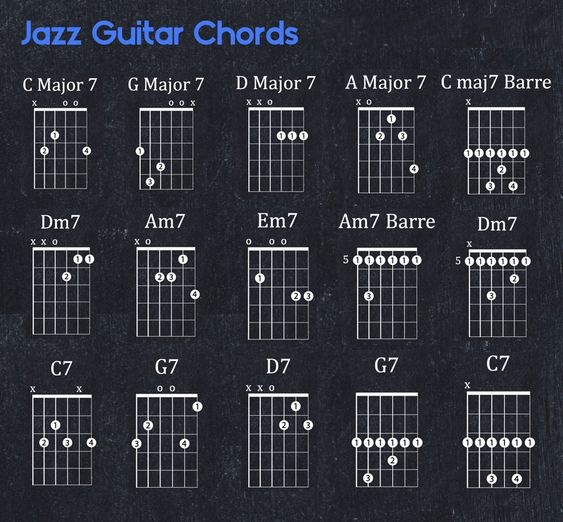How to Play Jazz Guitar Chords with Chord Charts
Jazz guitar chords are the heart and soul of any jazz guitarist’s repertoire. Whether you’re a beginner or an experienced player looking to dive into the world of jazz, understanding and mastering jazz chords is essential. In this guide, we’ll explore how to play jazz guitar chords with the help of chord charts, which will provide you with a solid foundation for jazz improvisation and chord melody playing. So grab your guitar, and let’s get started!


The Basics of Jazz Guitar Chords
Before we dive into using chord charts, let’s first understand the basics of jazz guitar chords. In jazz music, chords are often more complex than the basic major and minor chords you might encounter in other genres. Jazz guitarists use extended chords, altered chords, and various voicings to create the unique harmonic texture associated with jazz. Here are some essential jazz chord concepts to keep in mind:
- Seventh Chords: Jazz chords frequently include seventh chords, such as major 7th, minor 7th, dominant 7th, and minor 7th flat 5 (also known as half-diminished). These chords add color and richness to jazz progressions.
- Extensions: Jazz chords often include extended notes like the 9th, 11th, and 13th. These extensions help create the distinct jazz sound.
- Altered Chords: Altered chords involve adding or altering certain notes to create tension and movement in the harmony. Common alterations include flat 9, sharp 9, flat 5, and sharp 5.
- Chord Inversions: Jazz guitarists frequently use chord inversions to create smooth voice leading between chords and add variation to their chord progressions.
Now, let’s move on to the practical part of playing these jazz chords using chord charts.
Using Chord Charts
Chord charts are invaluable tools for jazz guitarists. They provide a visual representation of chords and their fingerings. To make the most of chord charts, follow these steps:
Step 1: Understand the Symbols
Jazz chord charts use symbols to represent chords. Some common symbols include:
- Cmaj7: A major 7th chord based on the C root note.
- Dm7: A minor 7th chord based on the D root note.
- G7: A dominant 7th chord based on the G root note.
- Am7b5: A minor 7th flat 5 chord based on the A root note.
Step 2: Study the Fingerings
Each chord chart provides specific fingerings for the chord. These fingerings are illustrated on a grid, representing the fretboard. Pay attention to the numbers and lines indicating which fingers to use and where to place them on the fretboard.
Step 3: Practice the Chords
Begin by practicing each chord slowly and accurately. Pay attention to your finger placement and try to produce clear, clean-sounding chords. It’s essential to build muscle memory for these shapes.
Step 4: Apply Chords to Jazz Standards
Once you’re comfortable with various jazz guitar chords, it’s time to apply them to jazz standards. Start with simple progressions and gradually work your way up to more complex tunes. Analyze the chord progressions in the songs and use your chord charts to play through them.
Common Jazz Guitar Chords
To get you started, here are some common jazz guitar chords along with their chord chart diagrams:
Major 7th Chord (Cmaj7):
e|-0-
B|-0-
G|-0-
D|-2-
A|-3-
E|-x-
Minor 7th Chord (Dm7):
e|-1-
B|-1-
G|-2-
D|-0-
A|-x-
E|-x-
Dominant 7th Chord (G7):
e|-1-
B|-0-
G|-0-
D|-0-
A|-2-
E|-3-
Minor 7th Flat 5 Chord (Am7b5):
e|-0-
B|-1-
G|-0-
D|-1-
A|-x-
E|-x-
Major 6th Chords
Major 6th chords have a cheerful, airy quality and can be used to add variation to your jazz progressions.
Emaj6:
e|-0-
B|-1-
G|-0-
D|-2-
A|-2-
E|-0-
Minor 6th Chords
Minor 6th chords are less common but have a unique sound in jazz.
Cm6:
e|-0-
B|-1-
G|-0-
D|-2-
A|-x-
E|-x-
Diminished 7th Chords
Diminished 7th chords are dissonant and often serve as transitional chords in jazz progressions.
Bdim7:
e|-2-
B|-3-
G|-2-
D|-3-
A|-x-
E|-x-
You can find other diminished 7th chords by moving this shape around the fretboard.
Remember that mastering jazz guitar chords takes time and practice. Start with these basic chord shapes and gradually explore more advanced voicings, extensions, and alterations as you progress. To become proficient in jazz guitar, it’s essential to study jazz standards and learn how to apply these chords in various progressions and chord changes. Additionally, developing a good sense of timing and rhythm is crucial when playing jazz guitar. So, keep practicing and enjoy your journey into the world of jazz guitar!


Wow! This is lovely.
I want to be coached properly to the international standard on both Piano and Vocal ….